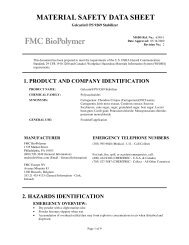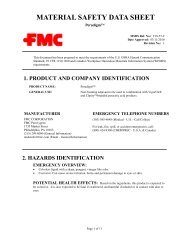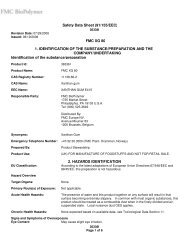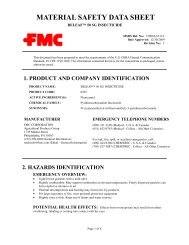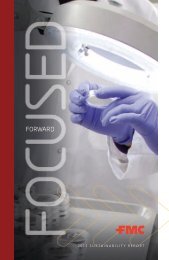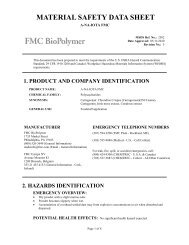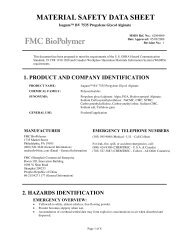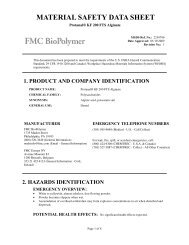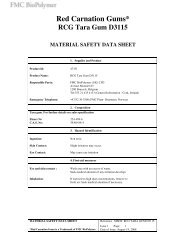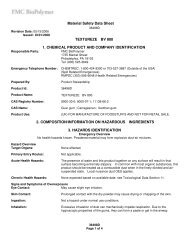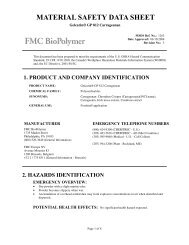Avicel® PC 815 Microcrystalline Cellulose - FMC Corporation
Avicel® PC 815 Microcrystalline Cellulose - FMC Corporation
Avicel® PC 815 Microcrystalline Cellulose - FMC Corporation
Create successful ePaper yourself
Turn your PDF publications into a flip-book with our unique Google optimized e-Paper software.
MATERIAL SAFETY DATA SHEET<br />
<strong>Avicel®</strong> <strong>PC</strong> <strong>815</strong> <strong>Microcrystalline</strong> <strong>Cellulose</strong><br />
Page 1 of 9<br />
MSDS Ref. No.: 160184<br />
Date Approved: 11/07/2005<br />
Revision No.: 3<br />
This document has been prepared to meet the requirements of the U.S. OSHA Hazard Communication<br />
Standard, 29 CFR 1910.1200; the Canada’s Workplace Hazardous Materials Information System (WHMIS)<br />
and, the EC Directive, 2001/58/EC.<br />
1. PRODUCT AND COMPANY IDENTIFICATION<br />
PRODUCT NAME: <strong>Avicel®</strong> <strong>PC</strong> <strong>815</strong> <strong>Microcrystalline</strong> <strong>Cellulose</strong><br />
CHEMICAL FAMILY: Polysaccharides<br />
SYNONYMS: <strong>Microcrystalline</strong> cellulose (INCI name): MCC, cellulose gel;<br />
Calcium alginate: Alginic acid, calcium salt<br />
GENERAL USE: Personal Care<br />
MANUFACTURER<br />
<strong>FMC</strong> BioPolymer<br />
1735 Market Street<br />
Philadelphia, PA 19103<br />
(800) 526-3649 (General Information)<br />
<strong>FMC</strong> Europe NV<br />
Avenue Mounier 83<br />
1200 Brussels, Belgium<br />
+32 2 / 775 8311 (General Information - Brussels)<br />
2. HAZARDS IDENTIFICATION<br />
EMERGENCY TELEPHONE NUMBERS<br />
(302) 451-0100 (<strong>FMC</strong> Plant - Newark, Delaware)<br />
(303) 595-9048 (Medical - U.S. - Call Collect)<br />
For leak, fire, spill, or accident emergencies, call:<br />
(800) 424-9300 (CHEMTREC - U.S.A. & Canada)<br />
(703) 527-3887 (CHEMTREC - All Other Countries)<br />
EMERGENCY OVERVIEW:<br />
• Off-white, free-flowing, odorless powder.<br />
• Powder becomes slippery when wet.<br />
• Accumulation of overhead settled dust may form explosive concentrations in air when disturbed and<br />
dispersed.<br />
POTENTIAL HEALTH EFFECTS: No significant health effects expected.
<strong>Avicel®</strong> <strong>PC</strong> <strong>815</strong> <strong>Microcrystalline</strong> <strong>Cellulose</strong> (160184) Date: 11/07/2005<br />
3. COMPOSITION / INFORMATION ON INGREDIENTS<br />
Chemical Name CAS# Wt.% EC No. EC Class<br />
<strong>Microcrystalline</strong> cellulose 9004-34-6 232-674-9 Not classified<br />
Calcium alginate 9005-35-0 None Not classified<br />
4. FIRST AID MEASURES<br />
EYES: Flush with plenty of water. Get medical attention if irritation occurs and persists.<br />
SKIN: Wash with plenty of soap and water.<br />
INGESTION: Drink plenty of water. Never give anything by mouth to an unconscious person. If any<br />
discomfort persists, obtain medical attention.<br />
INHALATION: Remove to fresh air. If breathing difficulty or discomfort occurs and persists, obtain<br />
medical attention.<br />
NOTES TO MEDICAL DOCTOR: This product is expected to have low oral, dermal and<br />
inhalation toxicity. It is expected to be non-irritating to the eyes and skin, and non-sensitizing to the skin.<br />
Ingestion of large quantities of alginates may cause intestinal obstruction. Aspiration or inhalation of<br />
alginates could cause chemical pneumonitis. Treatment is symptomatic and supportive.<br />
5. FIRE FIGHTING MEASURES<br />
EXTINGUISHING MEDIA: Water<br />
FIRE / EXPLOSION HAZARDS: As with any fine particulate matter, the accumulation of<br />
excessive dust on overhead structures may produce explosive concentrations when disturbed and dispersed.<br />
According to NFPA 68, (Explosion Venting Guide), the Hazard Class of Dust Deflagrations for<br />
microcrystalline cellulose is St-1, the lowest hazard class.<br />
FIRE FIGHTING PROCEDURES: For fires involving this material, do not enter any<br />
enclosed or confined fire space without wearing full protective clothing and self-contained breathing<br />
apparatus (SCBA) approved for firefighting. This is necessary to protect against the hazards of heat,<br />
products of combustion and oxygen deficiency. Do not breathe smoke, gases or vapors generated.<br />
Page 2 of 9
<strong>Avicel®</strong> <strong>PC</strong> <strong>815</strong> <strong>Microcrystalline</strong> <strong>Cellulose</strong> (160184) Date: 11/07/2005<br />
FLAMMABLE LIMITS: Not applicable<br />
6. ACCIDENTAL RELEASE MEASURES<br />
RELEASE NOTES: Powder becomes slippery when wet. Maintain good housekeeping practices<br />
to minimize accumulation of settled dust, especially on overhead surfaces. Sweep up the spilled material<br />
and dispose of in accordance with the waste disposal method outlined in Section 13, "Disposal<br />
Considerations".<br />
7. HANDLING AND STORAGE<br />
HANDLING AND STORAGE: Use local exhaust or general dilution ventilation to control<br />
exposure to dust. Always use safe lifting techniques when manually moving containers, especially when<br />
handling containers weighing more than 50 pounds (22.7 kg). To protect quality, store in a tight container<br />
in a dry place. Avoid exposure to excessive heat. Keep material out of lakes, streams, ponds and sewer<br />
drains.<br />
8. EXPOSURE CONTROLS / PERSONAL PROTECTION<br />
EXPOSURE LIMITS<br />
Chemical Name ACGIH OSHA Supplier<br />
<strong>Microcrystalline</strong><br />
cellulose<br />
10 mg/m 3 (TWA)<br />
PERSONAL PROTECTIVE EQUIPMENT<br />
Page 3 of 9<br />
15 mg/m 3 (PEL) (total<br />
dust)<br />
5 mg/m 3 (PEL)<br />
(respirable fraction of<br />
dust)<br />
EYES AND FACE: Whenever airborne dust concentrations are high, appropriate<br />
protective eyewear, such as mono-goggles, should be worn to prevent eye contact.<br />
RESPIRATORY: Whenever dust in the worker's breathing zone cannot be controlled with<br />
ventilation or other engineering means, workers should wear respirators or dust masks approved by<br />
NIOSH/MSHA, EU CEN or comparable certification organization to protect them against airborne<br />
dust.<br />
PROTECTIVE CLOTHING: No special clothing is required.<br />
GLOVES: No special gloves are required.<br />
COMMENTS:
<strong>Avicel®</strong> <strong>PC</strong> <strong>815</strong> <strong>Microcrystalline</strong> <strong>Cellulose</strong> (160184) Date: 11/07/2005<br />
ADDITIONAL EXPOSURE LIMITS:<br />
MCC:<br />
Australia (TWA) 10 mg/m³<br />
Belgium (TWA) 10 mg/m 3 (inhalable dust)<br />
China (STEL): 25 mg/m³<br />
China (TWA): 10 mg/m³<br />
Hong Kong (TWA): 10 mg/m³<br />
Ireland (TWA): 10 mg/m³ (inhalable dust)<br />
Korea (TWA): 10 mg/m³<br />
New Zealand (TWA): 10 mg/m³ (respirable dust with no asbestos and less than 1% free silica)<br />
Singapore (PEL): 10 mg/m³<br />
Switzerland (TWA): 3 mg/m³ MAK (respirable)<br />
United Kingdom (STEL): 10 mg/m³ (total inhalable dust)<br />
United Kingdom (TWA): 10 mg/m³ (total inhalable dust); 4 mg/m³ (respirable dust)<br />
9. PHYSICAL AND CHEMICAL PROPERTIES<br />
ODOR: Odorless<br />
APPEARANCE: Off-white, free-flowing powder<br />
BOILING POINT: None volatile<br />
COEFFICIENT OF OIL / WATER: (Octanol/Water) Not applicable<br />
EVAPORATION RATE: (Butyl acetate = 1) Not applicable<br />
FLASH POINT: Not applicable<br />
MELTING POINT: Not available<br />
PERCENT VOLATILE: Not available<br />
pH: 5.8 - 6.5 (in solution)<br />
SOLUBILITY IN WATER: (% by weight): Not available<br />
SPECIFIC GRAVITY: (H2O = 1): 1.54<br />
VAPOR DENSITY: Not available<br />
VAPOR PRESSURE: Not available<br />
COMMENTS:<br />
EXPLOSIVE PROPERTIES: <strong>Microcrystalline</strong> cellulose: St-1<br />
MINIMUM IGNITION TEMPERATURE: <strong>Microcrystalline</strong> cellulose: 420°C<br />
Page 4 of 9
<strong>Avicel®</strong> <strong>PC</strong> <strong>815</strong> <strong>Microcrystalline</strong> <strong>Cellulose</strong> (160184) Date: 11/07/2005<br />
10. STABILITY AND REACTIVITY<br />
CONDITIONS TO AVOID: None known<br />
STABILITY: Stable<br />
HAZARDOUS DECOMPOSITION PRODUCTS: None known<br />
11. TOXICOLOGICAL INFORMATION<br />
EYE EFFECTS: Non-irritating (rabbit)<br />
SKIN EFFECTS: Non-irritating (rabbit)<br />
DERMAL LD50: > 2,000 mg/kg (rat)<br />
ORAL LD50: > 5,000 mg/kg (rat)<br />
INHALATION LC50: > 5.35 mg/l (4 h) (rat) Maximum attainable concentration - zero mortality<br />
SENSITIZATION: (Skin) Non-sensitizing (guinea pig)<br />
ACUTE EFFECTS FROM OVEREXPOSURE: This product is expected to have low<br />
oral, dermal and inhalation toxicity. It is expected to be non-irritating to the eyes and skin, and nonsensitizing<br />
to the skin. Ingestion of large quantities of alginates may cause intestinal obstruction. Aspiration<br />
or inhalation of alginates could cause chemical pneumonitis.<br />
CHRONIC EFFECTS FROM OVEREXPOSURE: This product was non-mutagenic<br />
in the Ames assay. <strong>Microcrystalline</strong> cellulose is considered an inert dust which is not toxic to the lungs<br />
when exposures are properly controlled. A ninety-day animal study showed no adverse effects when<br />
administered in the diet. <strong>Microcrystalline</strong> cellulose was negative in the Ames mutagenicity assay, and<br />
caused no chromosome damage in the mouse micronucleus assay. No adverse human effects are known.<br />
The alginates in this product are classified as safe and non-toxic. The Joint WHO/FAO Expert Committee<br />
on Food Additives (JECFA) has granted an Acceptable Daily Intake (ADI) of "not specified" (no upper<br />
limit), the best possible classification for food additives (JECFA, 39th session of 23/12 February 1992).<br />
CARCINOGENICITY:<br />
NTP: Not listed<br />
IARC: Not listed<br />
OSHA: Not listed<br />
OTHER: ACGIH: Not listed<br />
Page 5 of 9
<strong>Avicel®</strong> <strong>PC</strong> <strong>815</strong> <strong>Microcrystalline</strong> <strong>Cellulose</strong> (160184) Date: 11/07/2005<br />
12. ECOLOGICAL INFORMATION<br />
ENVIRONMENTAL DATA: No data available for the formulation. <strong>Microcrystalline</strong><br />
cellulose is inherently biodegradable in soil. It biodegrades in soil at a rate comparable to corn starch. The<br />
alginates in this product are biodegradable. This product is not expected to have significant environmental<br />
effects.<br />
ECOTOXICOLOGICAL INFORMATION: No data available for the formulation.<br />
The components of this formulation are not expected to have significant environmental effects.<br />
MCC:<br />
48-hour LC50 > 100%, Saturated solution; NOEC = 100% (daphnia)<br />
96-hour LC50 > 100%, Saturated solution; NOEC = 100% (rainbow trout)<br />
96-hour EC50 > 100%, Saturated solution; NOEC = 12.5% (algae)<br />
13. DISPOSAL CONSIDERATIONS<br />
DISPOSAL METHOD: No special disposal methods are suggested. It is the user's responsibility<br />
to comply with all applicable local, state, and federal laws, rules, regulations and standards.<br />
14. TRANSPORT INFORMATION<br />
U.S. DEPARTMENT OF TRANSPORTATION (DOT)<br />
PROPER SHIPPING NAME: National Motor freight Classification Item<br />
71390, Flour <strong>Cellulose</strong>, Edible.<br />
MARINE POLLUTANT: None<br />
ADDITIONAL INFORMATION: Not listed in Title 49 of the U.S. Code of<br />
Federal Regulations as a hazardous<br />
material.<br />
INTERNATIONAL MARITIME DANGEROUS GOODS (IMDG)<br />
ADDITIONAL INFORMATION: Not regulated<br />
ADR - EUROPEAN AGREEMENT CONCERNING THE<br />
INTERNATIONAL CARRIAGE OF DANGEROUS GOODS BY ROAD<br />
Page 6 of 9
<strong>Avicel®</strong> <strong>PC</strong> <strong>815</strong> <strong>Microcrystalline</strong> <strong>Cellulose</strong> (160184) Date: 11/07/2005<br />
ADDITIONAL INFORMATION: Not regulated<br />
INTERNATIONAL CIVIL AVIATION ORGANIZATION (ICAO) /<br />
INTERNATIONAL AIR TRANSPORT ASSOCIATION (IATA)<br />
ADDITIONAL INFORMATION: Not regulated<br />
OTHER INFORMATION:<br />
Canada (TDG) : Not applicable<br />
15. REGULATORY INFORMATION<br />
UNITED STATES<br />
SARA TITLE III (SUPERFUND AMENDMENTS AND REAUTHORIZATION ACT)<br />
SECTION 302 EXTREMELY HAZARDOUS SUBSTANCES (40 CFR 355, APPENDIX A):<br />
Not listed<br />
SECTION 311 HAZARD CATEGORIES (40 CFR 370):<br />
Not applicable<br />
SECTION 312 THRESHOLD PLANNING QUANTITY (40 CFR 370):<br />
The Threshold Planning Quantity (TPQ) for this product, if treated as a mixture, is 10,000 lbs;<br />
however, this product contains the following ingredients with a TPQ of less than 10,000 lbs.:<br />
None<br />
SECTION 313 REPORTABLE INGREDIENTS (40 CFR 372):<br />
This product does not contain any toxic chemicals subject to the reporting requirements of<br />
Section 313, Title III of the SARA (Superfund Amendments and Reauthorization Act) of<br />
1986.<br />
CERCLA (COMPREHENSIVE ENVIRONMENTAL RESPONSE COMPENSATION AND<br />
LIABILITY ACT)<br />
CERCLA DESIGNATION & REPORTABLE QUANTITIES (RQ) (40 CFR 302.4):<br />
Not listed<br />
TSCA (TOXIC SUBSTANCE CONTROL ACT)<br />
TSCA INVENTORY STATUS (40 CFR 710):<br />
Listed (components)<br />
Page 7 of 9
<strong>Avicel®</strong> <strong>PC</strong> <strong>815</strong> <strong>Microcrystalline</strong> <strong>Cellulose</strong> (160184) Date: 11/07/2005<br />
CANADA<br />
WHMIS (WORKPLACE HAZARDOUS MATERIALS INFORMATION SYSTEM):<br />
Domestic Substance List: Listed (components)<br />
E NUMBERS:<br />
E 460(i) (microcrystalline cellulose)<br />
E 404 (calcium alginate)<br />
INTERNATIONAL LISTINGS<br />
MCC<br />
Australia (AICS): Listed<br />
China: Listed<br />
Japan (ENCS): (8)-568<br />
Korea: KE-05339<br />
Philippines (PICCS): Listed<br />
Calcium alginate<br />
Australia (AICS): Listed<br />
China: Listed<br />
Japan (ENCS): (8)-237<br />
Korea: KE-00489<br />
Philippines (PICCS): Listed<br />
HAZARD, RISK AND SAFETY PHRASE DESCRIPTIONS:<br />
EC Symbols: (Not classified as hazardous)<br />
EC Risk Phrases: (Not classified as hazardous)<br />
EC Safety Phrases: (Not classified as hazardous)<br />
16. OTHER INFORMATION<br />
NFPA<br />
Health 2<br />
Flammability 1<br />
Reactivity 0<br />
Special None<br />
No special requirements<br />
NFPA = National Fire Protection Association<br />
Page 8 of 9
<strong>Avicel®</strong> <strong>PC</strong> <strong>815</strong> <strong>Microcrystalline</strong> <strong>Cellulose</strong> (160184) Date: 11/07/2005<br />
Degree of Hazard Code:<br />
4 = Extreme<br />
3 = High<br />
2 = Moderate<br />
1 = Slight<br />
0 = Insignificant<br />
REVISION SUMMARY:<br />
This MSDS replaces Revision #2, dated January 18, 2005.<br />
Changes in information are as follows:<br />
Section 1 (Product and Company Identification)<br />
Section 15 (Regulatory Information)<br />
Section 16 (Other Information)<br />
Avicel and <strong>FMC</strong> BioPolymer Logo - <strong>FMC</strong> Trademarks<br />
© 2005 <strong>FMC</strong> <strong>Corporation</strong>. All Rights Reserved.<br />
Page 9 of 9



